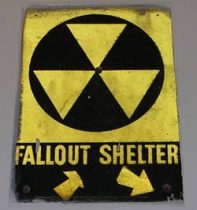In The Dying City: Postwar New York and Ideology of Fear, Brian Tochterman described how the Cold War dropped “flight” and “hysteria” like bombs upon New Yorkers as they struggle to organize their own “civil defenses” because of “overcrowding” of buildings and the lack of preparation to defend the city, however, it still offers “a great opportunity” to create solutions and plan constructions for shelters.[1] He mentioned that the government would contribute “shelter,” food, water, clothes, blankets, and other survival necessities for civilians that are “willing to stay” in New York.[2] In 1962, Layhmond Robinson, the writer of a New York Times article titled “U.S. Is Combing State for Fall-Out Shelter Sites,” announced that “[two thousand] architects and

engineers” were searching for appropriate buildings to protect people from rising tensions and possible nuclear attacks.[3] President John F. Kennedy authorized this plan as a part of a multi-million dollar “nation-wide program,” which was to provide protection for United States citizens.[4] Robinson added that “basements,” “subways,” and “tunnels” would count as shelters and should “accommodate fifty people.”[5] When most of the larger buildings were filled with people, Robinson reported that New York City’s Council requested for residents and other building owners to “establish shelters” for others who need them.[6] In her journal article, Sarah Lichtman discussed how shelter advocacy increased when the New York Council requests spread. She described the shelter advocacy as an “ideologically charged national do-it-yourself project” because it involved assisting citizens to seek shelter, especially in someone else’s home.[7] Lichtman defined the “do-it-yourself” project as a “home improvement with family safety,” which provided reassurance of “control in increasingly uncertain times.”[8] In order to notify others of the availability of sanctuaries, the owners of the buildings, transformed into shelters, were supplied with fallout shelter signs.
The fallout shelter signs (pictured above) were hung up on the exterior buildings to let people know these buildings were available to stay in during the Cold War tensions under stressful predicaments of nuclear attacks. According to the blogger of the Civil Defense Museum, the Department of Defense contributed and posted more than one million signs, which costed nearly seven hundred thousand dollars, inside and outside of the shelters.[9] Besides symbolizing caution, the black and yellow colors also signaled “trained leadership,” medical necessities, “food and water,” a safeguard from “radiation,” and surveillance to “determine safe areas and time.”[10] The blogger cited Bill Geerhart’s blog post, highlighting the background of the fallout signs. The “Civil Defense Museum” blogger shared that Geerhart even interviewed the man, Robert Murtha, who was responsible for posting the fallout shelter signs. According to Geerhart, the “first fallout shelter sign” was displayed in 1961 at the Westchester County Building, located at 148 Martine Avenue in White Plains, New York (picture of the Building below this paragraph).[11] The Westchester County building also accommodated more seventeen hundred people.[12] Geerhart reported that Robert S. McNamara, the secretary of Defense, received criticism from Abraham Ribicoff, the Secretary of Health, Education and Welfare, regarding the meaning of the fallout sign symbols.[13] Ribicoff claimed that the signs “looked too much like the Atomic Energy Commission radiation symbol” and he was concerned about people confusing the signs with “danger,” rather than the signs of sanctuary provision and reassurance of military protection.[14] Even though the shelter signs were taken down after the end of the Cold War, they serve as a vintage symbol of the geopolitical conflict.
[1] Brian Tochterman, The Dying City: Postwar New York and Ideology of Fear, (University of North Carolina Press, 2017), 71
[2] Ibid.
[3] Layhmond Robinson, “U.S. Is Combing State for Fall-Out Shelter Sites,” New York Times, January 10, 1962, pg. 21
[4] Ibid.
[5] Ibid.
[6] Ibid.
[7] Sarah Lichtman, “Do-it-Yourself Security: Safety, Gender, and the Home Fallout Shelter in Cold War America,” Journal of Design History 19 (2006): 39
[8] Ibid
[9] National Fallout Shelter Program – Public Fallout Shelter Signs, Civil Defense Museum, http://www.civildefensemuseum.com/signs/, accessed April 27, 2020.
[10] Ibid.
[11] Bill Geerhart, “An Indelible Cold War Symbol: The Complete History of the Fallout Shelter Sign,” Conelrad Adjacent Blog Spots, http://conelrad.blogspot.com/2011/06/indelible-cold-war-symbol-complete.html, accessed 27 April 2020.
[12] Ibid
[13] Ibid
[14] Ibid
